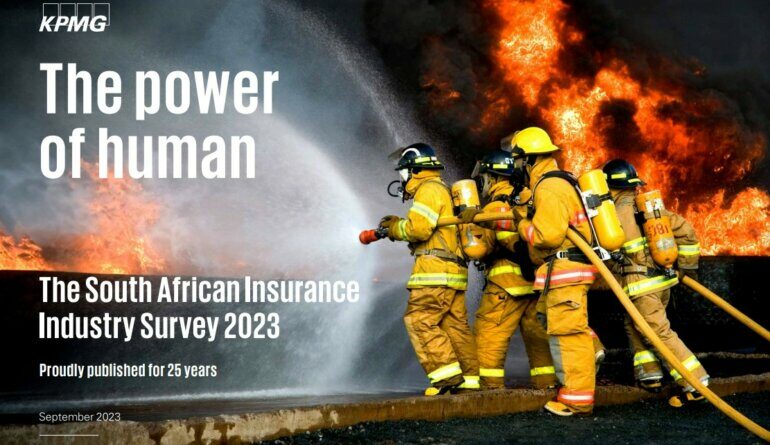KPMG insurance survey 2023: harnessing technology and relationships to gain competitive advantage and build trust
KPMG South Africa today launched its annual South African Insurance Industry Survey for 2023, its 25th anniversary edition. Thirty-one non-life insurers, seventeen life insurers, and four reinsurers were surveyed. The non-life insurance industry results were largely characterised by the impact of the Kwa-Zulu Natal floods in April 2022, the July 2021 civil unrest, and a hardened global and local reinsurance market. Life insurers have benefited from the normalisation of mortality levels post the COVID-19 pandemic and a number of successful corporate transactions. The industry continued to demonstrate its resilience in the context of GDP growth of only 2%, high levels of unemployment, interest rate hikes, and local infrastructure challenges.
“For non-life insurers, 2022 was marked by the significant extent of losses experienced from the Kwa-Zulu Natal floods, one of the deadliest and costliest flood events on record in South Africa, and the R33 billion in losses experienced by Sasria from the July 2021 riots,” says Mark Danckwerts, partner and Africa insurance practice leader at KPMG.
“Across the board, insurers reflected on how they have had to navigate one of the most difficult periods in history over the last few years. While the insurance sector has traditionally been cautious about embracing technological advancements, hesitating to harness technology, such as generative AI and robotics could be a strategic misstep. At its core, insurance is about problem-solving, and the use of technology emerges as a formidable ally in this mission. Given the challenges of the last two years, those that embrace these changes will be best positioned to carve out more profits in the form of efficiencies and improved customer loyalty” continues Danckwerts.
Non-life insurance industry
The non-life insurance industry reported gross written premiums (GWP) of R140.1 billion in 2022, reflecting an increase of 9.6% when compared to 2021. This is a strong top-line performance considering the overarching inflationary and economic growth environments and market competition. Excluding Sasria’s results, which are considered to be an outlier for 2022, profit after tax for the industry was R4.6 billion less than in the prior year, reflecting insurers’ exposure to higher natural hazards and increased reinsurance costs.
“As the cost of insurance claim increases it is inevitable that insurance premiums will increase; in fact, policyholders might have already seen sharp increases in their premiums,” adds Danckwerts. “Reinsurance cover is significantly more expensive than it was a year ago as global reinsurance companies reprice after the COVID-19 pandemic and as they recover from a number of unprecedented natural catastrophes. Many insurers are however doing what they can to bring these costs down by digitising, simplifying and automating processes, and applying other operating model adjustments across the value chain to drive efficiency and cost reductions.”
“Insurers are managing their risks and the premiums they charge by incorporating stricter underwriting processes. To an extent this means that they are reducing their risk tolerances, for example, by reassessing the extent of insurance cover they will provide on homes situated in flood-prone areas or vehicles situated where there are more accidents or incidences of theft.”
While the industry held up well in managing its exposure to increased natural catastrophe losses, insurers are encouraged to continue making comparisons using real-world events in their catastrophe modelling and taking steps to remediate any material gaps.
Life insurance industry results
Life insurers showed their resilience in 2022 with remarkable improvements in their results. This was especially pronounced following the two-year disruption triggered by the COVID-19 pandemic and a volatile global market.
GWP for life insurers surveyed increased by 4% from R275.2 billion in 2021 to R287.5 billion in 2022.
Furthermore, profit after tax increased over the period, from R17 billion in 2021 to R26.1 billion in 2022. This performance is reflective of the recovery and stabilisation experienced by life insurers to normalised mortality levels, post-COVID-19.
“While the South African life insurance industry has proven to be exceptional in dealing with the challenges of the last few years, there is still an opportunity for insurers to continue to create value for both shareholders and consumers. This is predicated on the industry being able to motivate many millions of people – especially younger generations – to understand and fully embrace life insurance. To do so, insurers will need to engage customers with tailored messages using data and technology. Secondly, as competition intensifies, we are likely to see several strategic partnerships to improve this sector’s digital reach into niche markets,” adds Danckwerts.
Reinsurance industry results
The 2022 financial year strategy for reinsurers was one of growth, recovery, and refocus. The continued constrained economic environment, lagging remnants of COVID-19, unreliable power supply, and unpredictable levels of natural catastrophes have influenced the 2022 results of reinsurers surveyed.
GWP of those reinsurers surveyed grew by 18% over 2022, a welcome reprieve following a downward trend experienced in the previous three years. The biggest contributors to this increase are the hardening of reinsurance rates, particularly from July 2023 renewals, repricing, and organic growth.
“The view of the market is that sufficient capacity is available to the primary market, on the basis that this is reflected in pricing structures. As a result, a hardening of reinsurance rates is expected to continue into the near future,” says Danckwerts. ”
Conclusion
According to Danckwerts, while the results of 2022 reflect a strong recovery, the road ahead is expected to be challenging with the advent of new and emerging risks including the continued erosion of social cohesion, climate change, and South African-specific challenges.
However, the collective effort of insurers and reinsurers alike over an exceptionally challenging past few years has ensured a sound outcome for policyholders and the common good.
“With significant opportunities for insurance companies to disrupt and reimagine how insurance works and reaches people, the future is potentially bright but this can only be achieved through the integration of technology and redefining the ways in which insurers interact with customers. For the visionaries in the insurance realm, the future is filled with potential,” concludes Danckwerts.




